Haibo Zhou
Sherman
Large-Scale AI in Telecom: Charting the Roadmap for Innovation, Scalability, and Enhanced Digital Experiences
Mar 06, 2025Abstract:This white paper discusses the role of large-scale AI in the telecommunications industry, with a specific focus on the potential of generative AI to revolutionize network functions and user experiences, especially in the context of 6G systems. It highlights the development and deployment of Large Telecom Models (LTMs), which are tailored AI models designed to address the complex challenges faced by modern telecom networks. The paper covers a wide range of topics, from the architecture and deployment strategies of LTMs to their applications in network management, resource allocation, and optimization. It also explores the regulatory, ethical, and standardization considerations for LTMs, offering insights into their future integration into telecom infrastructure. The goal is to provide a comprehensive roadmap for the adoption of LTMs to enhance scalability, performance, and user-centric innovation in telecom networks.
Large AI Model for Delay-Doppler Domain Channel Prediction in 6G OTFS-Based Vehicular Networks
Mar 03, 2025Abstract:Channel prediction is crucial for high-mobility vehicular networks, as it enables the anticipation of future channel conditions and the proactive adjustment of communication strategies. However, achieving accurate vehicular channel prediction is challenging due to significant Doppler effects and rapid channel variations resulting from high-speed vehicle movement and complex propagation environments. In this paper, we propose a novel delay-Doppler (DD) domain channel prediction framework tailored for high-mobility vehicular networks. By transforming the channel representation into the DD domain, we obtain an intuitive, sparse, and stable depiction that closely aligns with the underlying physical propagation processes, effectively reducing the complex vehicular channel to a set of time-series parameters with enhanced predictability. Furthermore, we leverage the large artificial intelligence (AI) model to predict these DD-domain time-series parameters, capitalizing on their advanced ability to model temporal correlations. The zero-shot capability of the pre-trained large AI model facilitates accurate channel predictions without requiring task-specific training, while subsequent fine-tuning on specific vehicular channel data further improves prediction accuracy. Extensive simulation results demonstrate the effectiveness of our DD-domain channel prediction framework and the superior accuracy of the large AI model in predicting time-series channel parameters, thereby highlighting the potential of our approach for robust vehicular communication systems.
Feedback-Free Resource Scheduling: Towards Flexible Multi-BS Cooperation in FD-RAN
Feb 25, 2025Abstract:Flexible cooperation among base stations (BSs) is critical to improve resource utilization efficiency and meet personalized user demands. However, its practical implementation is hindered by the current radio access network (RAN), which relies on the coupling of uplink and downlink transmissions and channel state information feedback with inherent issues such as overheads and delays. To overcome these limitations, we consider the fully-decoupled RAN (FD-RAN), in which uplink and downlink networks are independent, and feedback-free MIMO transmission is adopted at the physical layer. To further deliver flexible cooperation in FD-RAN, we investigate the practical scheduling process and study feedback-free downlink multi-BS resource scheduling. The problem is considered based on network load conditions. In heavy-load states where it is impossible for all user demands to be met, an optimal greedy algorithm is proposed, maximizing the weighted sum of user demand satisfaction rates. In light-load states where at least one solution exists to satisfy all user demands, an optimal two-stage resource allocation algorithm is designed to further minimize network energy consumption by leveraging the flexibility of cooperation. Extensive simulations validate the superiority of proposed algorithms in performance and running time, and highlight the potential for realizing flexible cooperation in practice.
ST-Mamba: Spatial-Temporal Mamba for Traffic Flow Estimation Recovery using Limited Data
Jul 11, 2024Abstract:Traffic flow estimation (TFE) is crucial for urban intelligent traffic systems. While traditional on-road detectors are hindered by limited coverage and high costs, cloud computing and data mining of vehicular network data, such as driving speeds and GPS coordinates, present a promising and cost-effective alternative. Furthermore, minimizing data collection can significantly reduce overhead. However, limited data can lead to inaccuracies and instability in TFE. To address this, we introduce the spatial-temporal Mamba (ST-Mamba), a deep learning model combining a convolutional neural network (CNN) with a Mamba framework. ST-Mamba is designed to enhance TFE accuracy and stability by effectively capturing the spatial-temporal patterns within traffic flow. Our model aims to achieve results comparable to those from extensive data sets while only utilizing minimal data. Simulations using real-world datasets have validated our model's ability to deliver precise and stable TFE across an urban landscape based on limited data, establishing a cost-efficient solution for TFE.
Spatial-Temporal Generative AI for Traffic Flow Estimation with Sparse Data of Connected Vehicles
Jul 10, 2024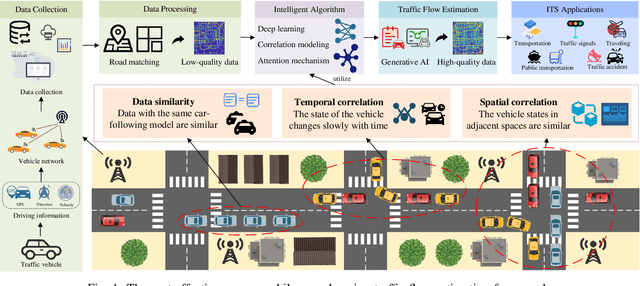

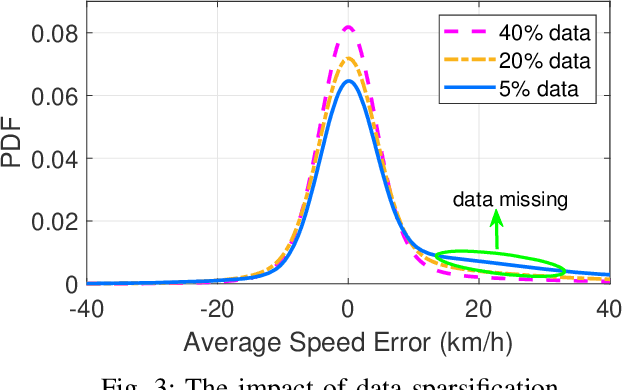
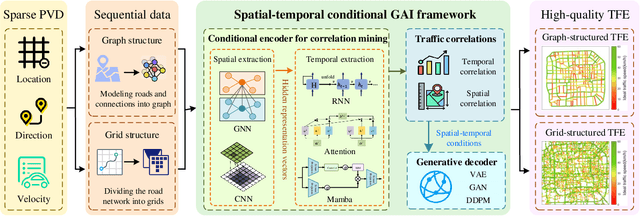
Abstract:Traffic flow estimation (TFE) is crucial for intelligent transportation systems. Traditional TFE methods rely on extensive road sensor networks and typically incur significant costs. Sparse mobile crowdsensing enables a cost-effective alternative by utilizing sparsely distributed probe vehicle data (PVD) provided by connected vehicles. However, as pointed out by the central limit theorem, the sparsification of PVD leads to the degradation of TFE accuracy. In response, this paper introduces a novel and cost-effective TFE framework that leverages sparse PVD and improves accuracy by applying the spatial-temporal generative artificial intelligence (GAI) framework. Within this framework, the conditional encoder mines spatial-temporal correlations in the initial TFE results derived from averaging vehicle speeds of each region, and the generative decoder generates high-quality and accurate TFE outputs. Additionally, the design of the spatial-temporal neural network is discussed, which is the backbone of the conditional encoder for effectively capturing spatial-temporal correlations. The effectiveness of the proposed TFE approach is demonstrated through evaluations based on real-world connected vehicle data. The experimental results affirm the feasibility of our sparse PVD-based TFE framework and highlight the significant role of the spatial-temporal GAI framework in enhancing the accuracy of TFE.
Spatial-Temporal Attention Model for Traffic State Estimation with Sparse Internet of Vehicles
Jul 10, 2024
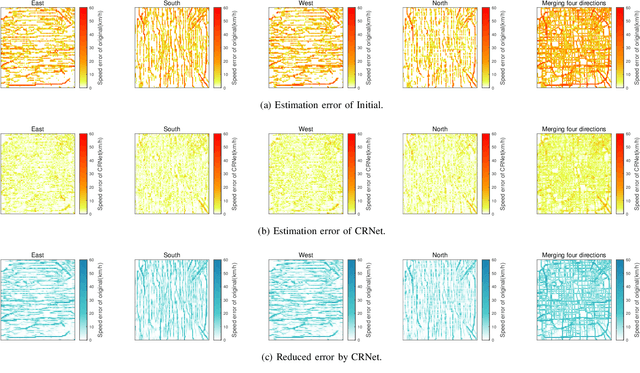
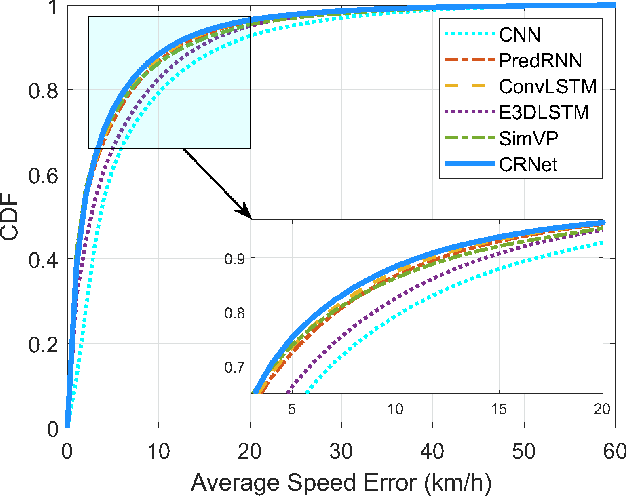

Abstract:The growing number of connected vehicles offers an opportunity to leverage internet of vehicles (IoV) data for traffic state estimation (TSE) which plays a crucial role in intelligent transportation systems (ITS). By utilizing only a portion of IoV data instead of the entire dataset, the significant overheads associated with collecting and processing large amounts of data can be avoided. In this paper, we introduce a novel framework that utilizes sparse IoV data to achieve cost-effective TSE. Particularly, we propose a novel spatial-temporal attention model called the convolutional retentive network (CRNet) to improve the TSE accuracy by mining spatial-temporal traffic state correlations. The model employs the convolutional neural network (CNN) for spatial correlation aggregation and the retentive network (RetNet) based on the attention mechanism to extract temporal correlations. Extensive simulations on a real-world IoV dataset validate the advantage of the proposed TSE approach in achieving accurate TSE using sparse IoV data, demonstrating its cost effectiveness and practicality for real-world applications.
Optimizing 6G Integrated Sensing and Communications (ISAC) via Expert Networks
Jun 01, 2024Abstract:Integrated Sensing and Communications (ISAC) is one of the core technologies of 6G, which combines sensing and communication functions into a single system. However, limited computing and storage resources make it impractical to combine multiple sensing models into a single device, constraining the system's function and performance. Therefore, this article proposes enhancing ISAC with the mixture of experts (MoE) architecture. Rigorously, we first investigate ISAC and MoE, including their concepts, advantages, and applications. Then, we explore how MoE can enhance ISAC from the perspectives of signal processing and network optimization. Building on this, we propose an MoE based ISAC framework, which uses a gating network to selectively activate multiple experts in handling sensing tasks under given communication conditions, thereby improving the overall performance. The case study demonstrates that the proposed framework can effectively increase the accuracy and robustness in detecting targets by using wireless communication signal, providing strong support for the practical deployment and applications of the ISAC system.
Coverage Analysis of Downlink Transmission in Multi-Connectivity Cellular V2X Networks
May 27, 2024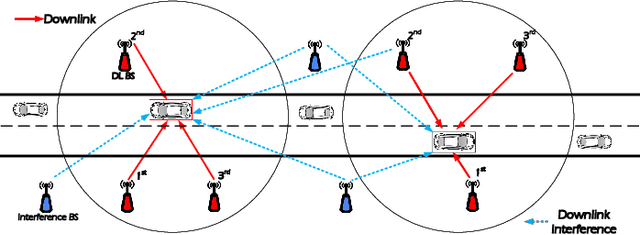

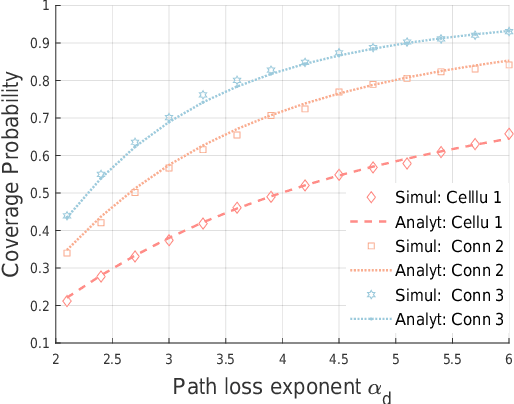
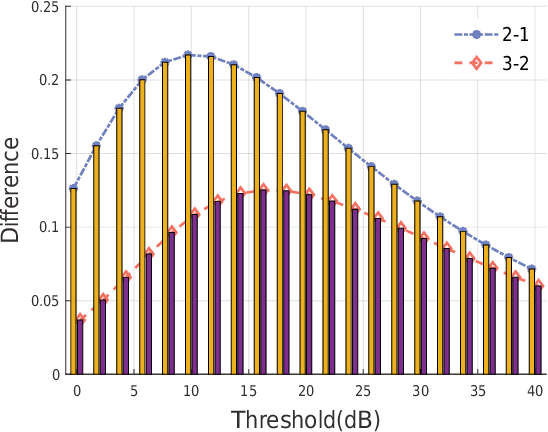
Abstract:With the increasing of connected vehicles in the fifth-generation mobile communication networks (5G) and beyond 5G (B5G), ensuring the reliable and high-speed cellular vehicle-to-everything (C-V2X) communication has posed significant challenges due to the high mobility of vehicles. For improving the network performance and reliability, multi-connectivity technology has emerged as a crucial transmission mode for C-V2X in the 5G era. To this end, this paper proposes a framework for analyzing the performance of multi-connectivity in C-V2X downlink transmission, with a focus on the performance indicators of joint distance distribution and coverage probability. Specifically, we first derive the joint distance distribution of multi-connectivity. By leveraging the tools of stochastic geometry, we then obtain the analytical expressions of coverage probability based on the previous results for general multi-connectivity cases in C-V2X. Subsequently, we evaluate the effect of path loss exponent and downlink base station density on coverage probability based on the proposed analytical framework. Finally, extensive Monte Carlo simulations are conducted to validate the effectiveness of the proposed analytical framework and the simulation results reveal that multi-connectivity technology can significantly enhance the coverage probability in C-V2X.
* 6 pagers, 5 figures. arXiv admin note: substantial text overlap with arXiv:2404.17823
Performance Analysis of Uplink/Downlink Decoupled Access in Cellular-V2X Networks
May 10, 2024Abstract:This paper firstly develops an analytical framework to investigate the performance of uplink (UL) / downlink (DL) decoupled access in cellular vehicle-to-everything (C-V2X) networks, in which a vehicle's UL/DL can be connected to different macro/small base stations (MBSs/SBSs) separately. Using the stochastic geometry analytical tool, the UL/DL decoupled access C-V2X is modeled as a Cox process, and we obtain the following theoretical results, i.e., 1) the probability of different UL/DL joint association cases i.e., both the UL and DL are associated with the different MBSs or SBSs, or they are associated with different types of BSs; 2) the distance distribution of a vehicle to its serving BSs in each case; 3) the spectral efficiency of UL/DL in each case; and 4) the UL/DL coverage probability of MBS/SBS. The analyses reveal the insights and performance gain of UL/DL decoupled access. Through extensive simulations, \textcolor{black}{the accuracy of the proposed analytical framework is validated.} Both the analytical and simulation results show that UL/DL decoupled access can improve spectral efficiency. The theoretical results can be directly used for estimating the statistical performance of a UL/DL decoupled access C-V2X network.
* 15 pages, 10 figures
Locally Differentially Private In-Context Learning
May 08, 2024Abstract:Large pretrained language models (LLMs) have shown surprising In-Context Learning (ICL) ability. An important application in deploying large language models is to augment LLMs with a private database for some specific task. The main problem with this promising commercial use is that LLMs have been shown to memorize their training data and their prompt data are vulnerable to membership inference attacks (MIA) and prompt leaking attacks. In order to deal with this problem, we treat LLMs as untrusted in privacy and propose a locally differentially private framework of in-context learning(LDP-ICL) in the settings where labels are sensitive. Considering the mechanisms of in-context learning in Transformers by gradient descent, we provide an analysis of the trade-off between privacy and utility in such LDP-ICL for classification. Moreover, we apply LDP-ICL to the discrete distribution estimation problem. In the end, we perform several experiments to demonstrate our analysis results.
 Add to Chrome
Add to Chrome Add to Firefox
Add to Firefox Add to Edge
Add to Edge